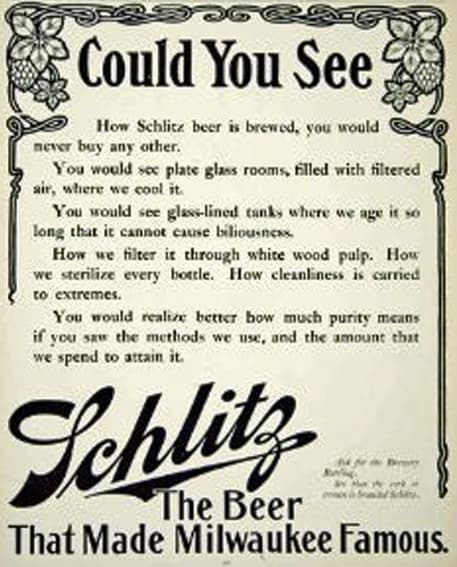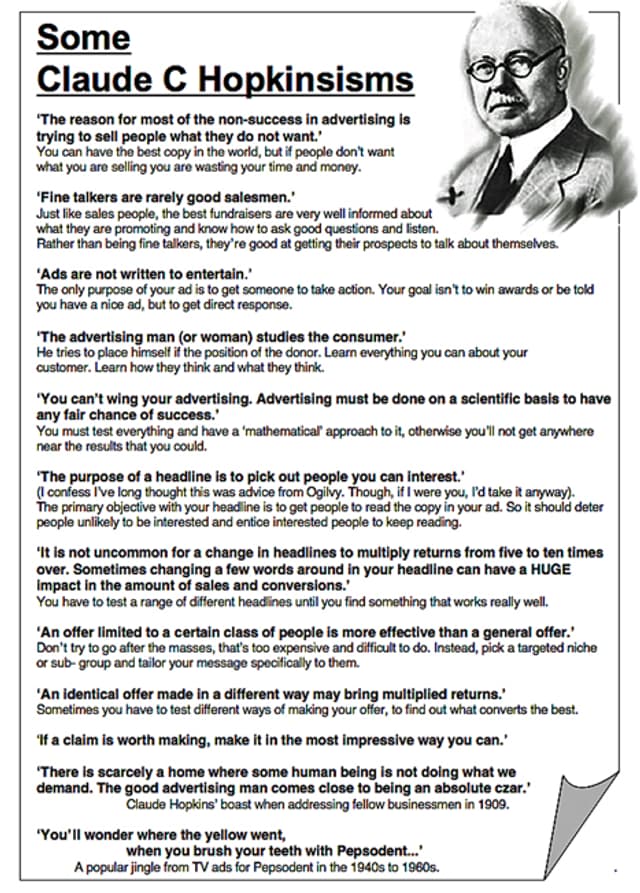Advertising’s earliest genius and how he can help your advertisements to work better, predictably
- Written by
- Claude Hopkins
- Added
- August 13, 2014
Book review

Scientific Advertising by Claude C Hopkins.
Reviewed by Ken Burnett.
At just 92 short pages and fewer than 10,000 words this may be one of the shortest classics you’ll ever read. Yet the great David Ogilvy says of Scientific Advertising, ‘Nobody should be allowed to have anything to do with advertising until he has read this book seven times. It changed the course of my life.’

Wow! That should make us think, should it not? Yet most fundraisers, I’m sure, are unlikely to have read it even once.
Scientific Advertisingwas first published in 1923, when Hopkins was already 57 years old. As with John Caples’ equally game-changing and priceless work Tested Advertising Methods the writing here is often arcane, the context very American, apparently dated and of dubious relevance. Hopkins can seem to be describing a different world at a different time. Yet the heart of this book is timeless and its messages – or at least, many of them – are as relevant today as they ever were. If you wish to communicate effectively you ignore this seminal book at your peril.

But ignore it most fundraisers probably will, because of the mindset that these days afflicts so many when it comes to studying the history and evolution of their craft. I’m reminded of the fundraiser who posted a comment following publication of an article from my archive that originally appeared in 2010. He queried the date. ‘So,’ he asked, ‘how much of this is still relevant in 2014, or is it just a typo?’ Indicative perhaps that, for some people, anything written as far back as 1923 won’t get even a first glance.
More the fools them.
Claude Hopkins created ‘reason-why advertising’. He was the first leading Madison Avenue figure to realise that advertising isn’t a matter of random chance but rather it can and should be precisely measured and tested, that it can in effect come close to being an exact science. He showed that advertising can reliably encourage and foster habits difficult to break, and can influence consumer behaviour directly, substantially and predictably. His book sets out the first ever description of the split-testing process and of coupon-based customer tracking and loyalty schemes. In Scientific Advertising Hopkins outlines an advertising approach based on meticulous testing and measuring where the cost of unsuccessful advertising is kept to a safe level while profits from effective ads are reinvested and multiplied. Or, as Hopkins put it, the advertiser is ‘playing on the safe side of a hundred to one shot’.

Hopkins’ greatest contribution to advertising was his insistence that all advertising could be measured and should be rigorously tested. This alone explains why his quirky little book, which has inspired and informed generations of advertising people, is still relevant and influential today to those with eyes to see and ears to listen.
According to David Ogilvy, Hopkins was the first advertising great to recognise the importance of brand images, a generation before the term came into regular use. His Scottish mother instilled in young Claude the values of working hard and learning constantly. At a time when advertising was an exalted occupation for upper crust types he used simple words and short phrases to describe everyday situations. He’s also widely credited, through his advertising, with popularising the twice-daily habit of brushing teeth.
Could this concise, revered classic be worth the time it’ll take you to read, digest and learn from its 92 short pages? Could it help you, to improve your results?
You decide.
And be reassured. Whether you think it can, or you think it can’t, you are right.

Schlitz beer was made in pretty much the same way as every other beer, yet Claude Hopkins told its story so brilliantly he transformed the brewer’s fortunes and literally ‘made Milwaukee famous’ and himself very rich.
© Ken Burnett 2014
This article also appears on Ken Burnett’s blog
The revolutionary advertising adventures of this brilliant if somewhat unprincipled giant of advertising, Claude C Hopkins, and his quest to create and break habits, feature prominently in the final chapter of Ken Burnett’s latest book, Storytelling can change the world.

About Ken Burnett
 Ken Burnett is author ofRelationship Fundraising and other books including The Tiny Essentials of an Effective Volunteer Board (The White Lion Press Limited, London, UK) and The Zen of Fundraising, (Jossey-Bass Inc, San Francisco, USA). Ken is also SOFII’s managing trustee.
Ken Burnett is author ofRelationship Fundraising and other books including The Tiny Essentials of an Effective Volunteer Board (The White Lion Press Limited, London, UK) and The Zen of Fundraising, (Jossey-Bass Inc, San Francisco, USA). Ken is also SOFII’s managing trustee.


















